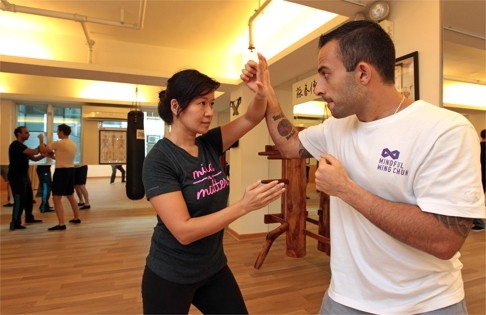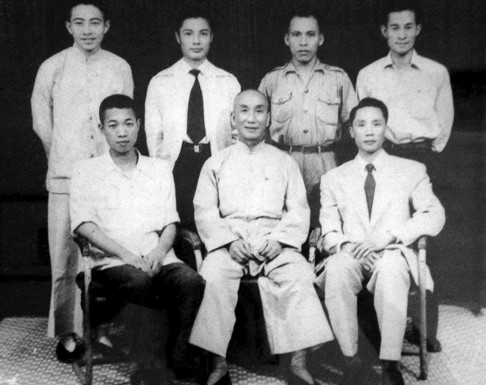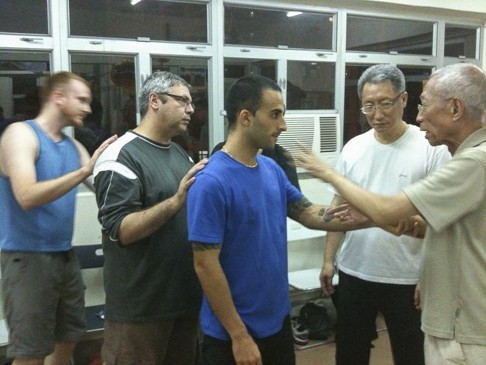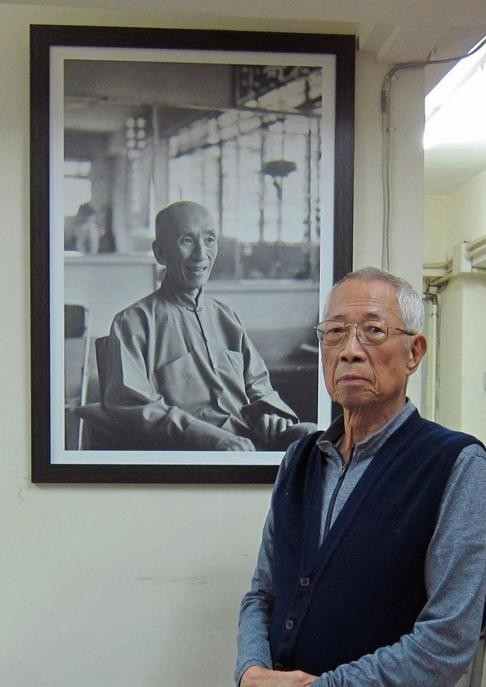
The Ip Man in all of us: classes teach kung fu for Hong Kong office workers
Studio in Central teaches wing chun martial art with focus on mindfulness to relax the muscles and give students a feeling of energised focus. It’s a great way to relieve stress, a common office problem

In the heart of Hong Kong, a block away from the Lan Kwai Fong entertainment district, a group of mainly white-collar workers gathers regularly to learn kung fu.
Banish any thoughts of flying fists at the office water dispenser, though. Nima King, head instructor at Mindful Wing Chun in the city’s Central district says more than half the studio’s clients attend classes to bring balance to their busy lives. Over 80 per cent of clients are office workers.

Research tells us our minds can often be elsewhere as a result of stress at work or in other areas of our lives. Any build-up of stress leads to health problems – including poor posture in the case of many office workers. King says wing chun offers a holistic remedy to the problem.
“In my opinion, wing chun is the essence of correct and efficient movement,” he says, “meaning the minimum use of muscular force to get the maximum result. For anyone learning this type of wing chun, no matter what they want to achieve – pain relief, stress relief, self-defence – they have to come through the root of mindfulness. When we are mindful of the body, we are able to tap into the muscles and relax them. Once we achieve this, the joints are freer and we move more efficiently.”
This is why everyone, from professional athletes to housewives, can benefit from mindful wing chun practice, says King.

Chu was giving a seminar in Australia in 2004 when King met him by answering the call for a volunteer to join him on stage.
“I was young and doing weights, and he was a very skinny old man. He said, ‘hold strong [onto my arm] and let me demonstrate something’. I thought, ‘I’m not going to hold as tight as I can; I don’t want to show him up in front of everyone’. Then he threw me with just a very small movement.”

“I was blown away. I thought, ‘I’ve got to go [to Hong Kong] and train directly under him’. So I started saving up and in six months, in 2005, I moved here,” King says.
He began training intensively alongside other students in Chu’s Prince Edward home, and continued to do so until Chu died last year. Photos on the wall of the Mindful Wing Chun studio depict Chu giving demonstrations. Older images show Chu with Ip and other students, while another portrays Ip and his most famous disciple, Bruce Lee.
King and his fellow instructors follow Chu’s tactile method of teaching, constantly correcting students’ posture to help them find their centre of balance and assess how the body feels, so any unnecessary muscular tension can be released.
Central to wing chun is the cultivation of nim lik, or the “fountain of youth”, which King defines as “the power gained from a highly focused mind”. It is reminiscent of qigong, another Eastern system, which cultivates what scientists now equate to the body’s electromagnetic energy.

To demonstrate siu nim tao, King instructs me how to stand appropriately and then, by gently squeezing certain muscles, I imagine the energy of nim lik moving up my spine and exiting like a fountain at the top. When King puts a hand on my abdomen and another on my upper back, and pushes, I feel my internal energy intensify and, incredibly, my body resists any pressure King exerts on me. Perhaps, as the Zen riddle goes, you’ll only understand it when you stop trying to rationalise it.
A lot of people, when they’re sitting on the sofa, will say, ‘I’m relaxed’, but it’s not mindful
The mindfulness in wing chun “is basically what scientists are calling the flow state”, King says, referring to a mental state in which a person is fully immersed in a feeling of energised focus.
King says he knows of no other studio in Hong Kong emphasising the internal aspect of wing chun.
Many wellness disciplines talk of relaxation, but don’t tell you how to achieve it, he adds.
“A lot of people, when they’re sitting on the sofa, will say, ‘I’m relaxed’, but it’s not mindful. In my opinion, relaxation like this is just compression, rather than a mindful relaxation, which is opening and expansion.”
There are various types of class available at Mindful Wing Chun, including forms (not unlike tai chi practise), dynamics (fighting and self-defence) and an all-inclusive general class. Private lessons are also available. All types of class focus on mindfulness, however. “We don’t know how else to teach wing chun,” King says.